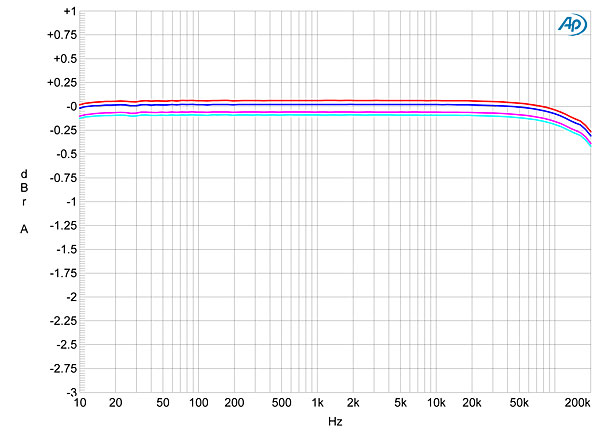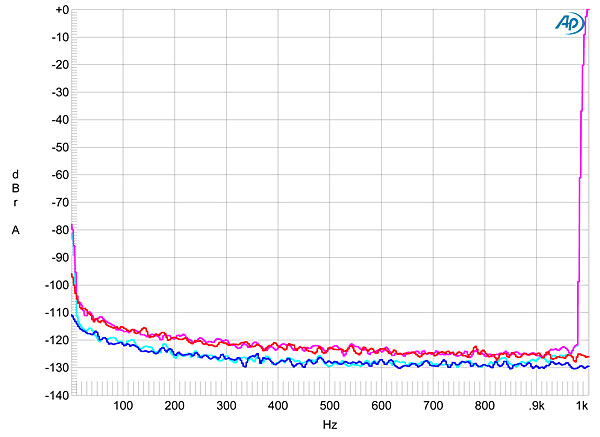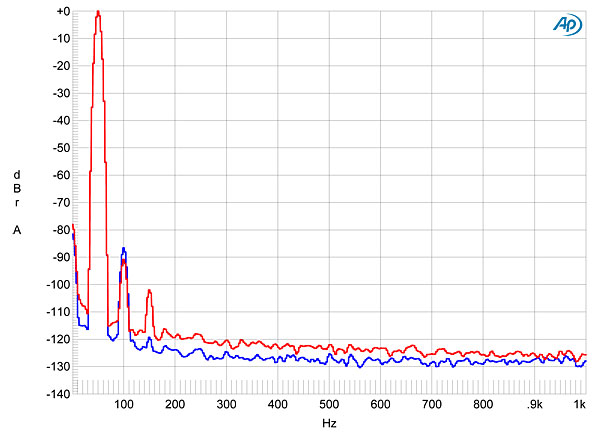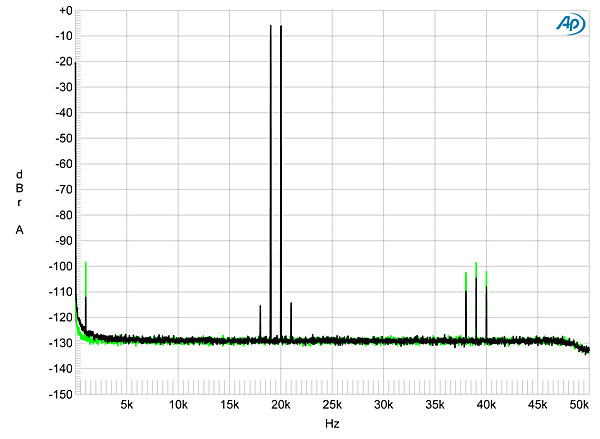| Columns Retired Columns & Blogs |
Very nice article. And yes, more money spent is required to beat the Pass Labs XP-30!
I measured the Ayre Acoustics KX-R Twenty's electrical performance with my Audio Precision SYS2722 system (see www.ap.com and the January 2008 "As We See It"). The volume control operated in accurate 1dB steps with the maximum gain obtained when it was set to "60." The sensitivity of each input can be independently adjusted with the Set-Up Menu, up to a maximum of +6dB. However, in that case the maximum setting of the volume control is reduced by the gain offset; eg, with an offset of +6dB, the maximum volume-control setting is now "54." The maximum gain for both balanced and unbalanced inputs to balanced outputs was 0.55dB. This is lower than the norm, but, as I wrote six years ago, it's something I welcome, as preamplifiers in general are used to attenuate the levels of source signals, not to amplify them. The low maximum gain will be an issue only with audio systems that include very insensitive power amplifiers or speakers (such as Magnepan MG-20s) and a low-output source component (eg, a vintage FM tuner). In these situations, Ayre can supply alternative gain-setting resistors to be installed by the dealer. I tended to use control settings between "40" and "50" for the bulk of my auditioning with the dCS Vivaldi set to 2V maximum output, though the insensitive Nola speakers driven by the Audio Research amplifier required closer to "55" to achieve appropriate loudness with classical recordings.
The KX-R Twenty's input impedance was very high, at more than 1 megohm unbalanced and 2 megohms balanced. I cannot give more specific values, as the voltage-drop method I use to measure input impedance becomes increasingly inaccurate as the device under test's input impedance increases. The KX-R Twenty preserved absolute polarity (ie, was non-inverting) with both balanced and unbalanced inputs. The XLR jacks are wired with pin 2 hot, the AES convention. The preamplifier's balanced output impedance was much lower than the specified 300 ohms, at 8 ohms across the audioband, which is a good thing: It should minimize cable interactions.
As with the original KX-R, the Twenty's frequency response didn't change with volume-control setting, load impedance, or frequency. The balanced response (fig.1) was flat almost to 100kHz, and down by just 0.25dB at the 200kHz limit of my measurements; the response with an unbalanced source (fig.2) was still flat to 50kHz, but rolled off a little faster above 100kHz than with a balanced source, reaching –1.25dB at 200kHz. The channel matching was never less than superb at all volume-control settings. Channel separation was around 120dB in both directions in the midrange and below, and still 108dB at 20kHz.


The advantage of the VGT circuit topology used by Ayre for the KX-R and KX-R Twenty is that when the signal level is reduced with the volume control, the noise level is also reduced. The signal/noise ratio, expressed in terms of the signal level, will therefore remain constant. Alternatively, when referred to a constant output level, as is my standard practice, the S/N ratio will increase as the volume-control setting decreases. For example, the wideband, unweighted S/N ratio (ref. 1V output) of the left channel with the volume control set to the maximum was 75.1dB, which increased to 88.7dB when the measurement bandwidth was reduced to the audioband, and to 91.6dB when A-weighted. Reducing the volume by 6dB increased these ratios by 6dB; setting the volume control to its minimum increased the ratios to 105dB (wideband, unweighted), 118.4dB (22Hz–22kHz), and 121dB (A-weighted). Spectral analysis of the Ayre's low-frequency noise floor with the preamplifier handling both a zero input signal and a 1kHz tone at 1.9V, both with the volume control set to "60" (fig.3), revealed that there were no supply-related spuriae in the noise floor, but that the right channel (red and magenta traces) had a very slightly higher level of random noise than the left (blue, cyan).

Plotting the THD+noise percentage in the Ayre preamp's output against output voltage into 100k ohms with the volume control set to "60" (fig.4) revealed that the signal had not been fully clipped when I reached the maximum output voltage of the Audio Precision signal generator. At 27V output, the THD+N was 0.31%, and we define clipping as when it reaches 1%. The downward slope of the trace to the left of this graph indicates that the distortion remains buried below the noise floor below 2.5V output, suggesting a sensibly arranged gain architecture. Unlike the original KX-R, the Twenty's level of distortion did not increase by very much as the load impedance dropped to 600 ohms, and commendably remained constant with frequency, at a very low 0.005% at 2V output (fig.5).


The distortion signature was slightly different in the two channels, with the right channel, driving 50Hz at 2V into 100k ohms, offering equal amounts of second and third harmonics at –108dB (fig.6, red trace, 0.00033%), while the second harmonic was higher in the left channel (blue trace), at a still very low –93dB (0.002%). Reducing the load impedance to 600 ohms gave equal levels of second harmonic in both channels, at –90dB (0.003%). Intermodulation distortion with an equal mix of 19 and 20kHz tones—which I have plotted to 50kHz rather than my usual 30kHz in order to show the second-order harmonic components (fig.7)—was very low. Even into 600 ohms, the difference component at 1kHz lies at almost –100dB (0.001%, not shown).


The original KX-R was a superbly well-engineered preamplifier. Not only is Ayre's 20th-anniversary update as well engineered, it can cope with low load impedances without its feathers becoming ruffled.—John Atkinson

Very nice article. And yes, more money spent is required to beat the Pass Labs XP-30!

but it sounds better than all of them I'm sure.

I wish this review compared the "dCS Vivaldi upsampling D/A system" with it's own digital domain VC in either 2v or 6v output mode and 2.3ohm output impedance, directly connected to the "Audio Research Reference 75" 300kohm input and 1.4v for full power input sensitivity.
It should even sound better without the KX-R Twenty in the signal path. Less is more if all lines up right, which this does!
The best a preamp can try to be, is a straight wire with or without gain, and in the direct connect above that's exactly what you will have, no pre perfect drive and just one set of interconnects.
Cheers George

Dear Mr. Atkinson,
it might not be widespread knowledge, but your experience with the Ayre pre-amplifier is not as unusual as one might expect. 'Detours' in fact can 'create sound' - sometimes in a very positive way.
Unfortunately we are still confronted with the persistent conception in HiFi circles , that physical- and engineering science expertise that proofs to be right in most technical applications should also be beneficial for the reproduction of recorded music. Given the metaphysical and therefore unseizable character of music, this misconception often leads to developements which might satisfy engineers' dreams but not that one of a listener. In this context It was pleasant to read about your personal experience with this 'voodoo'…..
klaus r.
(Germany)

Voodoo ? or great engineering ?